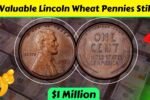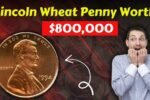Join on WhatsApp
Get the latest updates directly on WhatsApp – motivation, news & more!
The Lincoln Wheat Penny stands as one of the most iconic coins in United States history. Introduced in 1909 to mark the 100th anniversary of Abraham Lincoln’s birth, it became the first American coin to feature the portrait of a real person rather than symbolic figures. Designed by Victor David Brenner, the penny carried Lincoln’s image on the front and two wheat stalks on the reverse, a design that remained in circulation until 1958. For decades, it served as the common one-cent piece, carrying both practical and historical significance in everyday life.
The Truth About Extraordinary Value Claims
Stories often surface about Lincoln Wheat Pennies being valued at hundreds of millions of dollars. While these headlines generate excitement, they rarely align with reality. No Wheat Penny has ever sold for anything close to such an amount. The highest verified price belongs to a rare 1943 bronze penny, which reached around 1.7 million dollars in a major auction. These inflated claims often spread through social media or sensational articles, leading beginners to believe life-changing treasures may lie in spare change. In reality, values depend on rarity, errors, and condition rather than myths.
The Legendary 1943 Bronze Penny
The most famous Wheat Penny error occurred during World War II when the U.S. Mint replaced bronze with steel coated in zinc to preserve copper for military supplies. A few leftover bronze blanks were mistakenly struck with the 1943 date, creating one of the rarest coins in American numismatics. Experts believe only 15 to 20 authentic pieces exist, each carrying immense historical and financial value. These coins not only fascinate collectors but also serve as a reminder of the nation’s wartime sacrifices and resource conservation efforts.
Other Important Wheat Penny Rarities
While the 1943 bronze penny steals much attention, several other Wheat Pennies remain highly valuable. The 1955 Doubled Die shows dramatic doubling on its date and lettering, making it one of the most recognized errors. The 1969-S Doubled Die also carries high demand due to its striking visual characteristics. Collectors further seek out the 1909-S VDB, a coin that initially featured designer Brenner’s initials too prominently, leading to its quick alteration. Depending on rarity and condition, these coins can command thousands to hundreds of thousands of dollars.
Understanding Coin Authentication
Authentication stands at the heart of coin collecting. With Wheat Pennies, certain tests can help confirm authenticity. For example, 1943 steel pennies respond to magnets, while genuine bronze ones do not. Weight, color, and overall appearance also provide important clues. Professional grading services such as PCGS and NGC use advanced techniques to verify and grade coins, issuing certificates that boost their credibility in the market. Collectors are strongly advised against cleaning or altering coins, as such practices often destroy value rather than preserve it.
The Chances of Discovering Rare Pennies in Circulation
Finding a million-dollar Wheat Penny in regular pocket change is an extremely rare event. Most discoveries today come from inherited collections, estate sales, or dedicated searches rather than casual spending money. Circulated coins have often passed through many hands, lowering the likelihood of uncovering hidden treasures. However, unsearched jars or old boxes stored away for decades can still surprise collectors. While possible, these discoveries represent the exception rather than the rule.
Effective Coin Hunting Methods
Coin hunters who approach the hobby seriously adopt strategic methods. Searching through bank rolls allows quick examination of large numbers of pennies, though modern rolls usually contain recent coins. Better opportunities may appear at flea markets, estate auctions, and coin shows where older coins surface. Building relationships with experienced dealers also helps in learning about rare varieties and potential acquisitions. Tools such as magnifying glasses and detailed reference books prove invaluable for spotting subtle errors that can otherwise go unnoticed.
Building a Personal Wheat Penny Collection
Collecting Wheat Pennies offers both beginners and seasoned hobbyists an engaging path into numismatics. Many start by assembling complete date and mint mark sets, while others focus on error coins or rare variations. Proper storage in protective holders ensures that coins remain safe from environmental damage. Engaging with coin clubs or online communities not only enhances knowledge but also opens opportunities for trading and sharing discoveries. For most, the satisfaction lies as much in the process as in the rare finds themselves.
Balancing Enthusiasm with Realism
The excitement of possibly owning a rare and valuable coin should be tempered with realistic expectations. Most collections yield modest values rather than extraordinary sums. However, the educational benefits of learning about history, minting technology, and market behavior bring lasting rewards. Viewing coin collecting as a hobby rather than a quick path to wealth ensures greater enjoyment and wiser decisions. The true reward comes from connecting with history and craftsmanship that ordinary coins carry.
Final Note
Coin values constantly shift depending on collector demand, historical significance, and professional authentication. While stories about pennies worth hundreds of millions circulate widely, no such sale has ever been verified. Collectors should seek guidance from certified numismatists and established grading companies for accurate evaluations. Coin collecting thrives on curiosity, patience, and appreciation for history, making it a pursuit that continues to inspire generation after generation.



